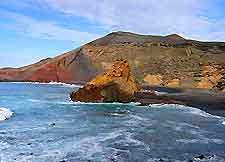Lanzarote History Facts and Timeline
(Lanzarote, Canary Islands, Spain)

Located off the coast of North Africa, this volcanic island was the first of the Canary Islands to be inhabited. The history of Lanzarote begins around 1100 BC, when the Phoenicians are believed to have arrived here.
At this time, Greek philosophers wrote about a fertile land in the Atlantic, where fragrant flowers bloomed and tropical fruits grew. After the Roman Empire fell in the 5th century, Lanzarote was left alone until the Arabs landed at the very end of the 10th century AD.
The name Lanzarote originates from the Genoese sea captain Lancelotto Malocello, otherwise known as 'Lanzarote da Framqua'. He arrived here from
Lisbon in the year of 1336, before building a fort near Costa Teguise, which is now considered one of the most attractive tourist areas on the island.
Spanish Conquest
In a quest to conquer the Canary Islands, the King of Castile enlisted the French explorer Jean de Béthencourt to lead an expedition here. He conquered the island in 1402, later taking
Fuerteventura. Béthencourt went on to become king of the Canary Islands, but still answered to Henry III of Castile, who had sponsored his expedition.
Lanzarote experienced several raids during the Middle Ages, notably an invasion by Ottoman Turks led by Murat Reis the Elder, in the year of 1585. In the 17th century, a pirate raid meant that some 1,000 of the island's inhabitants were enslaved and sent to the Cueva de los Verdes (the Green Caves).
Alegranza
On first arriving at Lanzarote's northernmost point, Béthencourt is said to have felt profound 'joy' on seeing land. This land referred to a small island now named Alegranza, Spanish for 'joy'. Alegranza belongs to a group of islets within the Chinijo archipelago and in turn, these belong to Lanzarote. This group also includes the small islands of Graciosa, Montana Clara, Roque del Este and Roque del Oeste. Alegranza remains uninhabited, although it is home to the Punta Delgado lighthouse, built in 1865. This lighthouse has since been recognised as an important historic monument.
Volcanic Eruptions
In 1730, Lanzarote was hit by a series of devastating volcanic eruptions, which lasted for almost six years. By 1736, more than 30 new volcanoes had been produced in the biggest natural disaster in the history of Lanzarote.
Over 25 percent of the island's area was covered by lava, burying villages and swamping farmland. As such, there are few remaining sites relating to ancient Lanzarote history, since many were completely engulfed with lava during these 18th-century eruptions. Meanwhile, various other relics were taken away by raiders in the Middle Ages.
In 1768, Lanzarote was hit by an extreme drought when its usual winter rains did not fall. This drought decimated the population, since many of its residents decided to emigrate to the Americas and
Cuba. In 1824, Lanzarote was hit by another major eruption, although much less powerful than those in the 18th century.
 Located off the coast of North Africa, this volcanic island was the first of the Canary Islands to be inhabited. The history of Lanzarote begins around 1100 BC, when the Phoenicians are believed to have arrived here.
Located off the coast of North Africa, this volcanic island was the first of the Canary Islands to be inhabited. The history of Lanzarote begins around 1100 BC, when the Phoenicians are believed to have arrived here.